In 1956, the Brooklyn Dodgers traveled to Japan for a 20-game exhibition tour following the end of their baseball season. This began the Dodgers organization’s relationships with Japanese baseball that included subsequent goodwill tours, visits by Japanese professional players to spring training at Vero Beach, and a Japanese stone lantern that still stands at Dodger Stadium in Los Angeles. All of these relationships culminated in the Dodgers’ signing of Hideo Nomo.
Dodgers team historian, Mark Langill, recently shared the fascinating story about the Dodgers’ tour of Japan in 1956 during the Japanese American National Museum’s virtual program on June 23, 2020. [Watch the program below.] Langill explained, “Dodgers owner, Walter O’Malley had a global vision for a bigger worldwide audience, so this was the perfect opportunity to grow the Dodger brand in Japan.” The Japan tour was the seedling of O’Malley’s global vision. Although O’Malley passed away in 1979, his son Peter O’Malley continued and expanded on his international vision, inspired by what he saw during the 1956 tour.
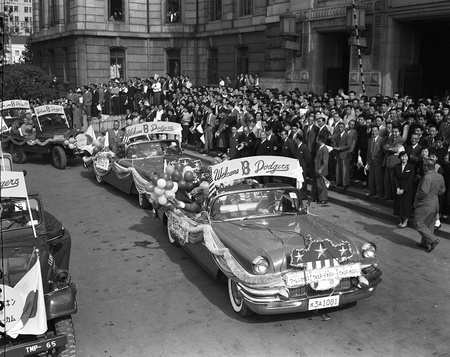
The impetus for the Dodgers tour
Early in 1956, legendary Japanese media mogul, Matsutaro Shoriki, wanted American Major League Baseball (MLB) players to play against Japanese teams throughout Japan. Shoriki founded Yomiuri Shimbun and the Yomiuri Giants, the oldest and one of the most popular baseball teams in Japan. Shoriki envisioned that an MLB team touring Japan would boost media revenues while improving the caliber of Japanese baseball. Langill explained, “The Dodgers were the defending champions in 1955 so it was natural that Shoriki would want to reach out to the world champions and get them to come to Japan.” O’Malley graciously and excitedly accepted Shoriki’s request for the Dodgers.1
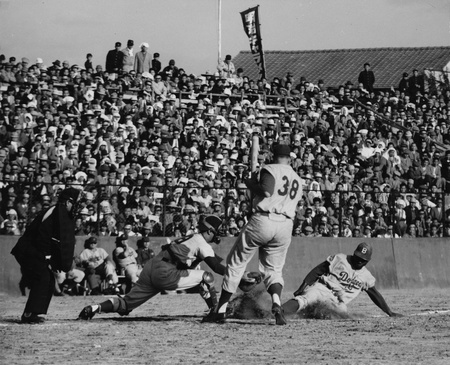
The Tour
Sponsored by the Yomiuri media conglomerate, the goodwill tour was an incredible experience for the Dodgers and the baseball-loving communities throughout Japan. Although the entire team did not travel to Japan, many stars did. In particular, these games would be Jackie Robinson’s final appearance as a player, since he would decide to retire before the start of the 1957 season. Additional stars included players Gil Hodges, Don Newcombe, Don Drysdale, and Roy Campanella; manager Walter Alston; and broadcaster Vin Scully (watch the program for some entertaining stories).
The Dodgers played against 19 of Japan’s best teams in their respective hometown stadiums. Many Dodgers’ wives also accompanied the tour and thoroughly enjoyed various activities that Shoriki’s team organized. The players and their wives experienced different Japanese cuisines, partook in tea ceremonies while dressed in kimono, enjoyed various cultural performing arts such as traditional plays, and visited temples and other sites.
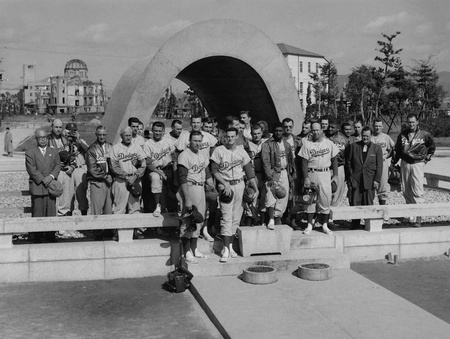
On November 1, 1956, the Dodgers went to Hiroshima to play against the Kanto All Star team. Before the game, the Dodgers visited the Hiroshima Peace Memorial. Langill described, “The Dodgers dedicated their game in Hiroshima to the memory of baseball fans and others who died in the atomic bombing of that city, and to peace. A bronze plaque was placed above the entrance of Hiroshima’s new baseball stadium. Inscribed were the words “We dedicate this visit in memory of those baseball fans and others who here died by atomic action on August 6, 1945. May their souls rest in peace and with God’s help and man’s resolution peace will prevail forever, amen.’” (A duplicate plaque is now on display at Dodger Stadium.)
One can imagine the mixed emotions that surrounded that day for both the Dodgers and Japanese. Only 11 years had passed since the U.S. dropped the atomic bomb on Hiroshima, which ended World War II. Only 4 years had passed since the end of U.S. occupation in 1952 in which the U.S. Army’s military governor relinquished sovereignty back to Japan. The Dodgers went on to finish the rest of the tour with a record of 14 wins, 4 losses, and 1 tie.

Fruitful relationships following the tour
The 1956 tour initiated longstanding relationships, starting with O’Malley and Shoriki, the respective owners of the Dodgers and Yomiuri Giants. Upon O’Malley’s invitation in the spring of 1957, a small group from the Giants traveled to the Dodgertown training complex at Vero Beach, FL, to train with the Dodgers. The Giants players were mesmerized by the enormous scale of the training grounds and comprehensive amenities that Dodgertown offered.
Subsequently in 1961, the entire Giants team—including home run legend Sadaharu Oh—traveled to Vero Beach to train with the Dodgers. The Giants were surprised that the Dodgers focused on the fundamentals during their training. Until that time, the Giants mainly focused on conditioning drills. In 1965, future Dodgers manager Tommy Lasorda and another top scout traveled to Japan as guest coaches to further train the Giants in all aspects of the game—including game fundamentals, scouting techniques, and the creation of a player development system. Before this time, the Giants focused on individual skills and did not have team tactics or strategies. The result of the Giants learning the “Dodger way of baseball” was astounding.2

The initial impact from the Giants’ 1961 spring training in Dodgertown at Vero Beach was immediate in which the Giants dominated Japan’s championships that year. Upon their victory, Shoriki sent a telegram to O’Malley stating: “Thanks to you, Yomiuri Giants captured Japan Series bringing into full play what they learned at Dodgertown.”3 Then for nine straight years from 1965 to 1973, the Giants won the Japanese championships. The Giants’ manager, Tetsuhara Kawakami, gave credit to the Dodgers for the Giants’ longest championship winning streak in baseball history.4 The Dodgers’ coaches and players taught invaluable lessons to their Giants counterparts through subsequent spring training visits in 1967, 1971 and 1975. The Dodgers prioritized the fundamentals over conditioning and team tactics over individual tactics.5
The Dodgers’ ties to Japanese baseball was not limited to the Giants. In addition to the spring training visits by the Yomiuri Giants, the Chunichi Dragons visited the Dodgers at Vero Beach in 1988.
Additional Goodwill Tours in Japan
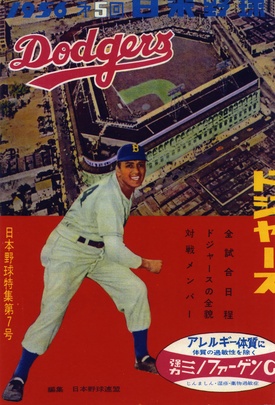
The Dodgers returned to Japan for a 18-game trip in 1966. In 1993, they returned for a 5-game tour of Japan and Taiwan. The group was led by now-manager Tommy Lasorda and included players Orel Hershiser, Mike Piazza, Pedro Martinez, and Eric Karros, among others. More recently, some Dodger players have participated in MLB All-Star goodwill tours, including Yasiel Puig in 2014, and Kenta Maeda, Chris Taylor, and Kiké Hernandez in 2018.
Dodgers’ Commitment to Japan
Akihiro “Ike” Ikuhara joined the Dodgers organization in 1965, working for Peter O'Malley. He played key roles in furthering the connections between the Dodgers and Japanese baseball.6
His son-in-law Acey Kohrogi served as Director of Asian Operations for the Dodgers. He opened a Dodgers’ office in Japan in 1988 and was instrumental in the signing of Hideo Nomo and subsequently other Japanese and Asian players. Scott Akasaki, the Dodgers’ current Director of Team Travel, began as an intern before joining the staff in 2000. He worked in the club’s Asian Operations Department, including as the team interpreter and eventually as Manager of Japanese Affairs. He spent a year running the Dodgers’ office in Japan before returning to the team in Los Angeles. Other Japanese and Japanese American staff established and maintained ongoing ties between the Dodgers and Japan.
Hideo Nomo

There is no record of Nomo’s actual reasons for signing up with the Dodgers versus another MLB team. Nomo grew up in the 1970s in Osaka, Japan to a working-class family. He was a shy and passive child with a passion for baseball. Upon graduating high school, professional scouts dismissed him because his tornado-styled pitching was inconsistent and erratic. In 1988, he succumbed to playing in the amateur leagues in which he reflected on his new reality. His year in the amateur leagues was a transformative and reflective time where he honed his pitching and developed his now-famous forkball.
In 1989, the Kintetsu Buffaloes professional team drafted him. He played well through 1994. Then, a provocative Los Angeles based agent, Don Nomura, spotted Nomo’s talent and found a loophole in Nomo’s contract that enabled him to play for the MLB. The only previous Japanese professional player to play in the MLB was Masanori Murakami, who pitched for the San Francisco Giants in 1964–1965. A contractual dispute with the Nankai Hawks resulted in his return to Japan. No other Japanese professional player had played in the MLB after that.
Nomo took an enormous risk with his future by declaring voluntary retirement from Japanese professional baseball in order to play in the MLB.7 30 years after Murakami, Hideo Nomo signed a minor league contract with the Dodgers on February 13, 1995. Despite facing controversy and resentment in Japan, Nomo made his Major League Baseball debut at San Francisco’s Candlestick Park on May 2, 1995, pitching five scoreless innings against the Giants. “Nomomania” was born as he went on to win the Rookie of the Year, exciting Japanese and Japanese American fans who avidly watched his every pitch, with games being broadcast live on giant screens in Japan.
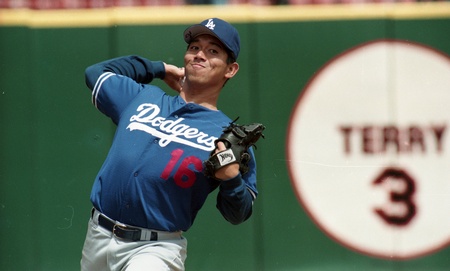
Nomo was not just a sensation to Japanese citizens and Japanese Americans, but to many other Americans. Baseball game sales increased an average of 8,000 tickets whenever Nomo played regardless whether the Dodgers played at home or away. An increase of this magnitude, especially for away games, likely meant that the increase included a significant number of people outside of the Japanese and Japanese American demographic.8 His success and popularity, as well as the posting system that was established to circumvent the “Nomo Clause,” paved the way for other Japanese stars to follow.
Hideo Nomo played for the Dodgers from 1995–1998, and then returned from 2002–2004. Other Japanese players who have played for the Dodgers include Masao Kida (2003–2004), Kazuhisa Ishii (2002–2004), Norihiro Nakamura (2005), Takashi Saito (2006–2008), Hiroki Kuroda (2008–2011), Kenta Maeda (2016–2019) and Yu Darvish (2017). Current Dodgers’ manager Dave Roberts, whose mother is Okinawan, was born in Okinawa, where his African American father was stationed. He played for the Dodgers from 2002–2004.
* * * * *
JANM Digital Film Festival—Dodgers: Brotherhood of the Game Q&A
Live stream on JANM’s YouTube channel
July 10 at 6 p.m. (PDT)
Mark Langill will be discussing Hideo Nomo, as well as other Dodgers’ trailblazers profiled in JANM’s 2014 Dodgers: Brotherhood of the Game exhibition.
Click here to join us for the Q&A, streamed live on Friday, July 10 at 6 p.m. (PDT) >>
* * * * *
Notes:
1. Originally, Matsutaro Shoriki desired an all-star MLB team to tour Japan, but administrative legalities with individual players’ contracts made it extremely difficult. Shoriki employed his confidant, Sotaro Suzuki, who discussed with Walter O’Malley an alternative in which the Dodgers would tour Japan in 1956. Mark Langill, “Brooklyn Dodgers – 1956 Tour."
2. Acey Kohrogi Interview #5, “Dodgers relationship with Japan,” on March 21, 2014, on Discover Nikkei.
3. Mark Langill, “Japan and Dodgertown,” Walteromalley.com.
4. Acey Kohroji Interview #6, “Walter O’Malley’s philosophy,” on March 21, 2014, on Discover Nikkei.
5. Brad Lefton, “Sixty Years Ago, the Dodgers’ Toured Japan and Changed Baseball Forever,” May 9, 2016, The Wall Street Journal.
6. Acey Kohroji Interview #5, “Dodgers relationship with Japan,” on March 21, 2014, on Discover Nikkei.
7. Robert Whiting, “Contract loophole opened door for Nomo’s jump,” October 10, 2010, The Japan Times sports section.
8. Acey Kohrogi Interview #4, “Nomo Attendance Boost,” on March 21, 2014, on Discover Nikkei.
© 2020 Daijiro Don Kanase




